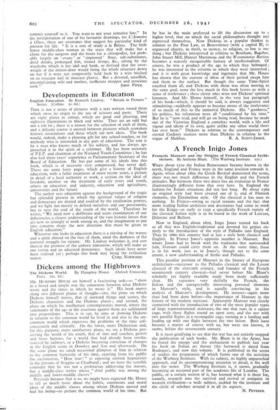A French Inigo Jones •
WHEN about 1510 the Italian Renaissance became known in the north, England and France were in the same position towards it. Again, when about 1800 the Greek Revival dominated the scene, there was not much difference in the English and the French attitudes. But between these two dates lies an evolution in France illuminatingly different from that over here. In England the fashion for Italian ornament did not last long. By about 156o an original style had been created out of it, and of Flemish elements, the Elizabethan style. Of the classical it has near to nothing. In France—owing to racial reasons and the fact that more leading Italian architects and decorators had come to work for the Kings—as early as 155o a specifically French variety of the classical Italian style is to be found in the work of Lescaut, Delorme and Bullant.
Now in England, about 162o, Inigo Jones turned his back to all that was English-traditional and devoted his genius en- tirely to the introduction of the style of Palladio into England. Thus by 166o this country had at last a style both classical and English. In France Jones's opposite number is Mansart. But where Jones had to break with the traditions that surrounded him, Mansart could carry them on. At the same time, there is in his work, just as in Jones's, though not to the same extent, a new understanding of Serlio and Palladio.
This peculiar position of Mansart in the history of European architecture—successor to the Palladio classical and the Lescot classical of the sixteenth century, and founder of the French seventeenth century classical—had never before Mr. Blunt's scholarly yet highly readable study been made sufficiently clear. He separates very skilfully the French, the Italian and the unexpectedly interesting personal elements in Mansart's style, and is equally convincing in his analysis of Mansart's development. He stresses—again more than had been done before—the importance of Mansart in the history of the modern staircase. Apparently Mansart was closely connected with the introduction of two of the most popular types of large representational staircases, the one that runs in a square cage, with three flights round an open core, and the one with two parallel flights in a rectangular cage, turning at a landing and leading up with one flight between the two below. Both have become a matter of course with us, but were not known, it seems, before the seventeenth century.
It is most gratifying to see that the war has not entirely stopped the publication of such books. Mr. Blunt is in the Army, but he found the energy • and the enthusiasm to publish last year his book on Italian art theory (the foreword is dated from Boulogne), and now this volume. It is published in the series of studies the preparation of which forms one of the activities of the Warburg Institute. With its subject, its highly unparochial approach, and its uncompromising attention to detail, it fits well into the series. The Warburg Institute is, it seems, gradually becoming an accepted part of the academic life of London. The public, or a certain section of it, has learned what it is there for, namely, research into the survival and revival of antiquity in western civilisation—a wide subject, tackled by the institute and the circle of scholars around it in all its aspects.
N. PEVSNER.






















 Previous page
Previous page